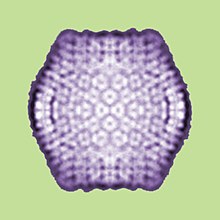Sputnik virophage
| Sputnik virophage | |
|---|---|
 |
|
| Virus classification | |
| Group: | Group I (dsDNA) |
| Order: | Unassigned |
| Family: | Lavidaviridae |
| Genus: | Sputnikvirus |
| Species: | Mimivirus-dependent virus Sputnik |
Sputnik virophage (from Russian cпутник "satellite", Latin "virus" and Greek φάγειν phagein "to eat") is a subviral agent that reproduces in amoeba cells that are already infected by a certain helper virus; Sputnik uses the helper virus's machinery for reproduction and inhibits replication of the helper virus.
Viruses like Sputnik that depend on co-infection of the host cell by helper viruses are known as satellite viruses. At its discovery in a Paris water-cooling tower in 2008 Sputnik was the first known satellite virus that inhibited replication of its helper virus and thus acted as a parasite of that virus. In analogy to the term bacteriophage it was called a virophage. However, the usage of this term and the relationship between virophages and classical satellite viruses remain controversial.
Sputnik was first isolated from a sample obtained from humans; it was harvested from the contact lens fluid of an individual with keratitis. Naturally however, the Sputnik virophage has been found to multiply inside species of the opportunistically pathogenic protozoan Acanthamoeba , but only if that amoeba is infected with the large mamavirus. Sputnik harnesses the mamavirus proteins to rapidly produce new copies of itself.
Mamavirus is formally known as Acanthamoeba polyphaga mimivirus (APMV) and is a close relative of the previously known mimivirus. The mimivirus is a giant in the viral world; it has more genes than many bacteria and performs functions that normally occur only in cellular organisms. The mamavirus is even larger than the mimivirus, but the two are very similar in that they form large viral factories and complex viral particles. There are conditions in which Sputnik cannot produce new virions within these viruses however. It has been observed that when Mimivirus is cultured with germ-free amoeba, bald virions are produced that lack the surface fibers that are characteristic of this virus. For reasons unknown, Sputnik is unable to replicate and produce new virions in these bald viruses. Virophage growth is deleterious to APMV and results in the production of abortive forms and abnormal capsid assembly of APMV. In one of the experiments done by inoculating Acanthamoeba polyphaga with water containing an original strain of APMV, it was discovered that several capsid layers accumulate asymmetrically on one side of the viral particle causing the virus to become ineffective. Sputnik decreased the yield of infective viral particle by 70% and also reduced the amoeba lysis by threefold at 24h.
...
Wikipedia
